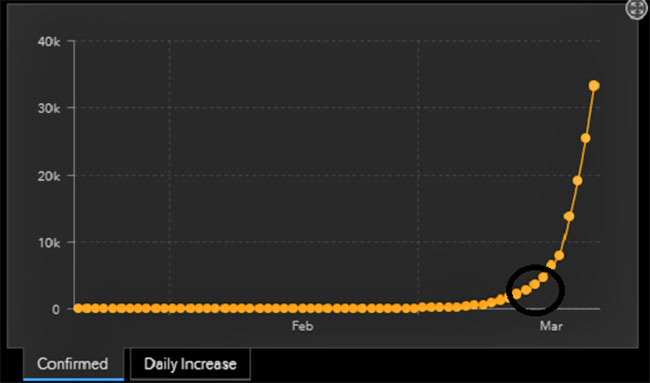|
from
ConservativeReview Website
The entire political focus of yesterday's news cycle was the legislative imbroglio between Republicans and Democrats over the coronavirus rescue package.
But nobody is asking:
These are not mere academic questions... They should determine our public policy response.
Knowing when the virus began and what we think occurred in January and February (and perhaps even December) will help determine not only how severe this virus is, but how far along we are into the epidemic.
If we really had hundreds of thousands, if not millions, of cases, along with several thousand more fatalities prior to testing, that would mean that the mortality rate is even lower than the 1.2% post-testing average so far.
It would also mean we are farther along in the epidemic and that many have already been exposed to it, thereby making a categorical and nationwide lockdown counterintuitive at this point.
What led our government and the governments of many other countries into panic was a single Imperial College of U.K. study (Behind the Virus Report That Jarred the U.S. and the U.K. to Action), funded by global warming activists, that predicted 2.2 million deaths if we didn't lock down the country...
In addition, the reported 8-9% death rate in Italy scared us into thinking there was some other mutation of this virus that they got, which might have come here.
Together with the fact that we were finally testing and had the ability to actually report new cases, we thought we were headed for a death spiral.
But again, as my colleague Steve Deace pointed out,
Take this chart from Johns Hopkins University School of Medicine, for example:
You see an insanely dangerous trajectory of cases taking off in March.
But what exactly happened in March?
The virus was introduced in Wuhan in November. And even without testing, we did detect a handful of cases here, the first known case being on January 21.
So why would we suddenly experience the outbreak in March?
It's quite evident that the culprit for the spike in the chart is simply because that is when the testing began because Trump dropped the FDA regulation barring private testing after the government testing didn't work.
Thus, we know with certainty that people were clearly contracting coronavirus and were likely dying some time before March, but we're still not sure how long before or how many people.
Given the overlap with the general flu and pneumonia season, we really have no way of knowing that the January 21 case of the individual flying from Wuhan to Spokane, Washington, was the first active case - patient zero.
It's truly inconceivable that it would take so long for the virus to come here after it broke out in China in November.
We likely had hundreds of thousands of travelers coming here and countless tens of thousands of Chinese nationals flying back even before Customs and Border Protection introduced any health care screening per CDC guidance on January 17.
There are roughly 3.4 million Chinese admissions every year, not counting the numerous Americans who fly there and back.
If we divide that by six to account for a two-month period before Trump shut off travel but after the virus had developed in Wuhan, that would be nearly 600,000 Chinese nationals.
It's safe to say that as January wore on, the numbers likely dropped a lot from the Chinese side, but it's still a statistical improbability that the virus wasn't brought in earlier and in greater numbers than CDC has thus far detected and documented.
Moreover, Chinese students in particular, including those from Wuhan, traveled back in mid-January for the new semester.
As Dr. Deborah Birx, the coordinator of Trump's coronavirus response task force, said yesterday of the spread in New York City,
If some of the pneumonia cases and deaths earlier this year were from coronavirus, that would mean that the death rate is much lower than predicted.
Even the Diamond Princess cruise ship, which was the ultimate petri dish of recycled air circulating an infection, with an elderly population, experienced a 1.25% fatality rate.
New York, which seems to be, by far, the worst hot spot now, has a mortality rate hovering between 0.75% and 0.80%, and it is going down as they test more cases.
That compares to 1.2% nationwide, which helps show that wherever we test and identify the virus, the numbers go way up, but the mortality goes down...
According to Gov. Andrew Cuomo, New York accounts for 25 percent of the nation's testing.
That means if every other state tested a larger sample of those who actually have the virus, their death rates would likely be as low as New York's.
This is what we are seeing in Germany, which tested more people than any other Western country, but has a mortality rate of 0.3%, despite having almost as large a proportion of seniors as Italy.
A mortality rate of 0.75% would still be three times higher than H1N1, which is very serious, but,
Given the evidence in front of us on the mortality rate, the fact that so many more likely have had it or were exposed to it, and the fact that the Asian countries are already getting over the worst of it,
Even in Italy, the virus is showing signs of peaking after four weeks.
Let's face it, either way, Congress' proposals will bankrupt us, but if our governments continue demanding indefinite lockdown, no amount of money in the world could solve this problem.
Some have suggested that it's due to the high elderly population, but that doesn't explain why the Diamond Princess had elderly mortality rates in line with the rest of the world.
I don't have the answer to that, but a plausible theory has been offered by Prof. Walter Ricciardi, scientific adviser to Italy's minister of health, that Italy is over-counting deaths...
Remember, Germany has just a 0.3% fatality rate, and Israel has just 1 death out of nearly 1,700 cases. Germany's demographic is almost as old as Italy's, while Israel's demographic is young.
Thus, other factors are at play here.
Clearly, we need answers before we destroy our way of life and our economy indefinitely. Yet these are the only answers the bipartisan cabal in Washington is uninterested in discovering.
Here's the ultimate question they need to answer:
In order to answer those questions, we need more information on how we got here...
|



